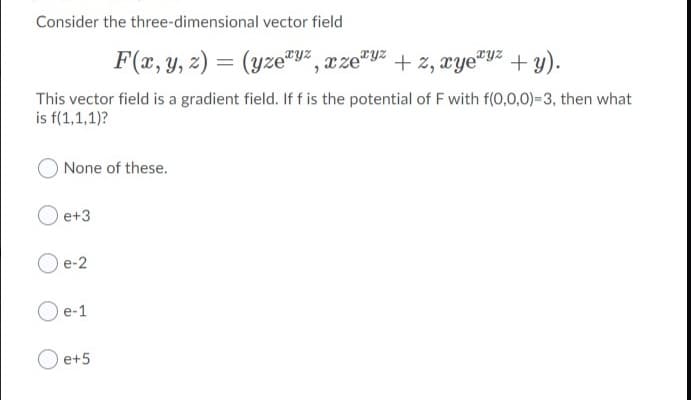Consider the three-dimensional vector field F(x, y, z) = (yze™y%, æze*y% + 2, xye™y² + y). zha This vector field is a gradient field. If f is the potential of F with f(0,0,0)-3, then what is f(1,1,1)? ONone of these. O e+3 Oe-2 Oe-1 e+5
Consider the three-dimensional vector field F(x, y, z) = (yze™y%, æze*y% + 2, xye™y² + y). zha This vector field is a gradient field. If f is the potential of F with f(0,0,0)-3, then what is f(1,1,1)? ONone of these. O e+3 Oe-2 Oe-1 e+5
Algebra and Trigonometry (MindTap Course List)
4th Edition
ISBN:9781305071742
Author:James Stewart, Lothar Redlin, Saleem Watson
Publisher:James Stewart, Lothar Redlin, Saleem Watson
Chapter9: Vectors In Two And Three Dimensions
Section9.FOM: Focus On Modeling: Vectors Fields
Problem 11P
Related questions
Question
Please solve correctly and provide correct option

Transcribed Image Text:Consider the three-dimensional vector field
F(x, y, z) = (yze"y², æze*v% + z, æye®yz
+ y).
This vector field is a gradient field. If f is the potential of F with f(0,0,0)=3, then what
is f(1,1,1)?
None of these.
O e+3
Oe-2
O e-1
e+5
Expert Solution
This question has been solved!
Explore an expertly crafted, step-by-step solution for a thorough understanding of key concepts.
Step by step
Solved in 2 steps with 2 images

Recommended textbooks for you

Algebra and Trigonometry (MindTap Course List)
Algebra
ISBN:
9781305071742
Author:
James Stewart, Lothar Redlin, Saleem Watson
Publisher:
Cengage Learning

Algebra and Trigonometry (MindTap Course List)
Algebra
ISBN:
9781305071742
Author:
James Stewart, Lothar Redlin, Saleem Watson
Publisher:
Cengage Learning